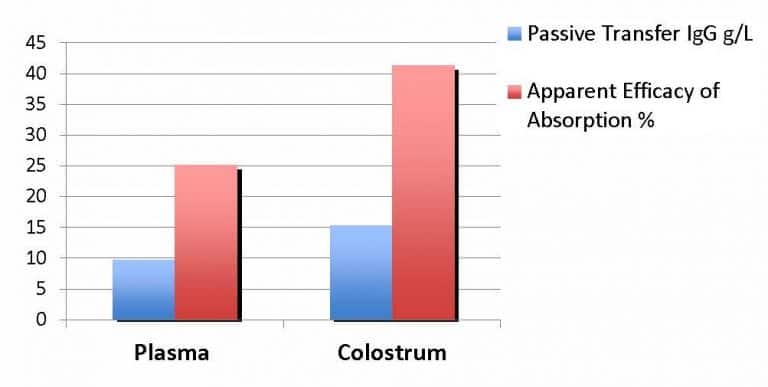As the cold weather sets in, so does the realization that calving season is right around the corner. Now is the time to start preparing your calving kit, and one of the most essential items to include is a colostrum supplement or replacer.
What is colostrum?
Calves are born nearly without immunity or antibodies in their system to protect them against pathogens. These pathogens can cause diseases like E. coli or salmonella, and can lead to diarrhea scours, dehydration and mortality. To avoid this, calves must consume adequate amounts of high-quality colostrum in a timely matter. Prior to calving, cows generate antibody-dense milk known as colostrum through a process called colostrogenesis. In ideal settings, a calf will stand and nurse adequate colostrum from its dam to achieve successful passive transfer of immunity. However, first-calf heifers or cows with poor nutrition can have lower quality colostrum or deficient volume for their calves to achieve this rate.
Passive transfer of immunity is defined as a serum total immunoglobulin (IgG) concentration of 10 g/L. This transfer of immunity is limited to 24 hours, and as soon as the calf is born, its ability to absorb IgGs begins to decline. It is said that the gut closes within this 24-hour period to where the calf can no longer absorb the essential immunity from colostrum. Many feel they therefore have an entire 24-hour period from birth for a calf to successfully absorb the many immune factors in colostrum; however, this is not necessarily true.
Research with passive transfer studies have shown that realistically a calf has only 12 hours from birth to absorb significant immune factors from colostrum. With that in mind, colostrum fed within the first six hours of life is most efficient in transferring immunity. Once 12 hours passes, the calves will absorb some of the factors in colostrum; however, the efficiency at which they do this is significantly impaired. In fact, the window of opportunity has passed and they run significant risk of failure of passive transfer. Because of this narrow window of opportunity, there may not be ample time to run to the local vet clinic or farm store to purchase an alternative colostrum solution. In these instances, it is important to have colostrum products already on hand.
What should I look for in a product?
There are several factors to consider when stocking up on colostrum products for calving season. First, not all colostrum products are made from actual colostrum, which means those derived from alternative sources do not provide the same immunity support as maternal colostrum. Serum- or plasma-based products, still contain IgG; however, when compared to colostrum, their antibodies are not as effectively absorbed into the blood stream and do not reach the same passive transfer levels in the blood.
As confirmed by the study conducted by Jon Ellis, Ph.D. and DVM from the University of Saskatchewan, the absorption of IgG from the colostrum-based product (>40%) was significantly greater than the plasma-based product (25%). Also, the results proved the average rate of IgG in the blood was less than 10 g/L, which is categorized as failure of passive transfer of immunity. Calves fed the colostrum-based product achieved above 15 g/L, successfully reaching passive transfer of immunity. Additionally, colostrum contains higher proportions of IgG1, the specific immunoglobulin that recirculates back onto key organs such as the gastrointestinal tract and lungs. This means colostrum-based products protect the lungs and gastrointestinal tract against viruses like bovine respiratory syncytial virus (BRSV) pneumonia or others like rotavirus which is implicated in many cases of diarrhea. Unfortunately, because the serum based products contain a significantly lower ratio of IgG1 and more IgG2, they therefore do no provide the same local immunity to the gastrointestinal tract and lungs.

Since bovine colostrum is a popular ingredient in not only other livestock products, but also in human nutritional products, several colostrum manufacturers will fractionate out the IgGs from the colostrum and sell the rest of the solution to be used in different products. However, colostral fat, the energy source naturally found in maternal colostrum, is essential for newborn calves. Colostral fat provides a long-term energy source for calves to thermoregulate in cold, snowy pastures. Alternative fat sources like mineral oil, cocoanut oil or vegetable oil, do not provide this same benefit, so it is important to always check the label to see if colostrum is being substituted for something of lesser nutritional value.
Colostrum is also concentrated with oligosaccharides, which serve as prebiotics to establish and fertilize healthy bacteria in the gastrointestinal tract. In fact, colostrum actually is the essential first step for a calf to begin building its key microbiota in the rumen and gastrointestinal tract.
When should I use a colostrum replacer or supplement?
Most colostrum products are considered supplements or replacers based on levels of IgG. Most products in the supplement category contain 50-100g IgG, and most replacers range from 100-200g IgG. Any product can be used to either supplement or replace maternal colostrum based on the amount fed. For instance, two bags of a 60g IgG product can be considered a replacement dose, because it equates to 120g IgG. The minimum dose needed to replace maternal colostrum can vary per calf based on factors like birthweight, environmental challenges like cold weather, or difficulty calving. New standards suggest feeding at least 120-150 g IgG for adequate replacement and 200g IgG for excellent replacement. Studies have shown calves receiving excellent replacement doses have less morbidity, so they are generally healthier and easier to manage.
Mike Nagorske, DVM and Director of Technical Veterinary Services and Research at SCCL, has established recommendations for supplementing or replacing colostrum for beef calves.
“Always first allow the dam to bond with her calf,” Nagorske said. “After that, if the calf has not stood and vigorously nursed within the first two hours, you can start with a supplement.”
In about six hours, if the calf is still not up to nurse, give another supplemental feeding to total a replacement amount. Calves born as twins, or in cold, muddy conditions, should initially be given a replacement dose. Nagorske explains calves born with stress in the form of major difficulty, c-section or an abnormal presentation time have significantly reduced ability to absorb antibodies and should be fed an excellent replacement dose of at least 200g IgG at bare minimum. Ideally, if you want a stressed calf to reach excellent immunity it is likely they may need 300-400 grams of IgG which means they will need multiple or additional feedings.
Regardless of the situation, colostrum is essential for newborn health and survivability. Being prepared with the right products and having them on hand to use quickly, might be the difference in having a live, healthy calf or a dead one.

